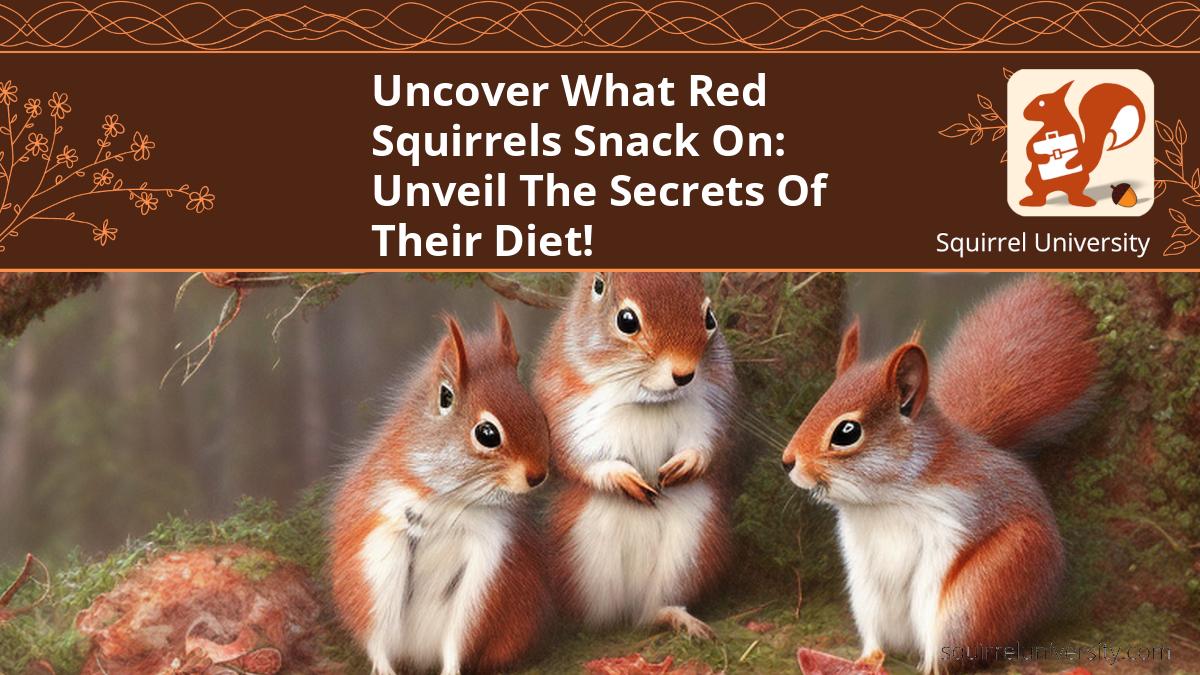As a self-proclaimed squirrel enthusiast, I know a thing or two about what red squirrels eat. After years of rigorous observation and research, I can confidently say that these fascinating creatures have a unique diet comprised of various foods. In this blog post, I’m going to uncover the secrets behind what red squirrels snack on so you can get an inside look into their diets! Be sure to keep reading to find out exactly what do red squirrels eat!
Red squirrels mainly eat a variety of tree seeds, such as spruce, fir, and pine cones. They also enjoy mushrooms, nuts (especially hazelnuts), berries, buds, shoots and flowers. In the winter months they often find food under snow by scratching away at it with their paws.
Red Squirrels and their Diet
Red squirrels are a true symbol of nature, and their diets are integral for their survival. Red squirrels feed mostly on tree seeds, supplemented by mushrooms, nuts, berries, buds and flowers found in the wild. During winter months they tend to scavenge for food from sources like bird tables or garden feeders.
What Do Red Squirrels Eat?
The diet of red squirrels can vary based on many factors such as location and season. However usual staples include: tree seeds (such as pine cones), mushrooms, nuts (acorns), berries (blueberries or raspberries) small animals such as insects and birds’ eggs when available, buds and flowers especially during spring and summer.
Tree Seeds
Red squirrels depend heavily on tree seeds for sustenance throughout the year – particularly during wintertime where food is scarce. The wide variety of tree species in each region tend to offer different types of edible seed such as acorns or pine nuts which red squirrels will naturally seek out if they’re available.
- Pine Cones: Red Squirrels prefer mature Pine Cone’s that are producing large amounts of edible soft fruit structure inside them
- Oak Trees: “Acorns” from Oak Trees provide an energy rich snack for red squirrels – often falling in abundance once trees have been pollinated in autumn/winter time.
Mushrooms, Nuts and Berries
Many other fungi-related foods can also provide valuable nourishment for these creatures – with various nuts hidden beneath coverings being a favourite snack option too! Berries from shrubs & bushes also make up part of the typical diet depending upon regional availability – blueberries & raspberries being the most commonly sought after options.
- Mushrooms: Various types of mushroom can be found growing within natural habitats offering protein-rich sustenance to these mammals.
- Nuts: Various kinds of nut harboured beneath protective covers offer a great source of energy & vitamins to red squirrel populations when available– hazelnuts being amongst favourites amongst these curious little critters!
Scavenging For Food In Winter Months
When traditional food sources become scarce due to colder climates & fewer daylight hours at this period– mice are often actively searched out by these rodents! They will often try scavenging human-created environments too in search for snacks– bird tables & garden feeders usually offering irresistible enticements that prove difficult to resist!
Understanding the Nutritional Habits of Red Squirrels
Red squirrels are native to Scotland and certain parts of England, and they inhabit both woodland areas and urban environments. These curious little mammals have an appetite for a wide variety of plant-based foods such as tree seeds, mushrooms, nuts, berries, and a variety of flowers. However, their favorite snack is undoubtedly tree seeds! Red squirrels are known to hoard large caches of these precious provisions in order to survive during winter months when food sources become scarce.
The Importance of Tree Seeds to Red Squirrels’ Diet
Tree seeds make up an important part of the red squirrel’s diet. This is especially true in the autumn months when pine cones offer plenty in terms of nutritious fuel for our furry friends. Acorns are also one of the most common meals eaten by red squirrels throughout the year as they contain essential proteins and fats needed for growth and development. Additionally, soft fruits are often added into their diets which can provide some much-needed hydration during warmer seasons!
Finding a Balance between Fruits, Nuts and Flowers in the Natural Environment
In addition to nuts and fruit, another important source of nutrition for red squirrels comes from wildflowers like clover or dandelion that tend to pop up around wooded areas. The nutritional balance offered by these flowers helps them maintain healthy blood sugar levels while also providing valuable vitamins that keep them fit in body size–not to mention bright eyes! It should be noted however that human intervention through artificial feeding plots may be necessary at times due to dwindling natural resources.
Impacting Factors on Red Squirrel Nutrition
Seasonal Variation of Diet for Red Squirrels
As mentioned previously, certain seasonal changes can alter what foods are available (and desirable) for red squirrel consumption. For example; during springtime birds lay eggs which can act as a supplemental source protein-rich nutrients along with potential insect larvae found near nests. In summer months local fruits like apples might be ripe enough for snacking whilst green leaves provide supplementary fibre elements.
- When autumn arrives abundant leaf drop may offer energy rich munchies if sticky coniferous sap isn’t readily available.
- Winter time finds this zippy critter utilizing its stores or scrounging around looking for any edible morsel it can find prior hibernation mode kicks in.
The Role of Human Interference on the Availability of Foods for Red squirrels
The human population has had both positive and negative impacts on red squirrel health. Due to extensive deforestation practices over recent centuries many regions now lack suitable environmental conditions required by these species including adequate access to nourishment – leading authorities such as The Wildlife Trust UK encourage observation programs aimed at tracking individual locations as well as reporting sightings back so appropriate steps can be taken towards conservation efforts where necessary.
Making Sure Your Garden is a Healthy Place For Your Local RedSquirrel Family!
Red Squirrels make great garden visitors and can bring charm, curiosity and joy to any outdoor area. However, in order for them to be able to enjoy your garden, it needs to provide the right food sources to support their natural diet. To ensure that you are doing all you can to encourage red squirrels into your space and provide them with the nutrition they need, here are some tips.
The Impact of Diet on Red Squirrel Health
Nutrition plays an important role in maintaining the health of red squirrels in both captive and wild settings. Understanding what these mammals eat in their natural environment as well as how nutritional deficiencies can affect their behavior and physical development is key when trying to create a suitable environment for them.
Nutrient Deficiencies in Wild Red Squirrels
Wild squirrels often experience nutrient deficiency due to inadequate food sources available during certain times of year. This may lead them to consume more unhealthy foods such as processed human foods or berries which are high in sugar content but low on other important nutrients. These poor eating habits can have a long-term effect on behavior, physical development and even longevity.
- Poorly balanced diets may lead to stunted growth rate or excessive weight gain – both of which harm their innate agility and speed;
- Nutrient deficiencies can also cause improper bone development leading to reduced mobility;
- Inadequate nutrition resulting from poor diet choices may also increase susceptibility towards diseases.
Effects of Inadequate Nutrition on Their Behavior, Physical Development and Longevity
Understanding dietary needs for each species is crucial for providing adequately balanced meals that meet their unique metabolic requirements. A lack of vitamins, minerals, proteins etc will affect growing young ones negatively, impacting survival rates. Simultaneously older individuals may become less active thus reducing reproductive capacity. With hindered locomotive abilities potential prey escape from sight causing increased starvation. Bad nutrition ultimately comes with further consequences such as weaker immune systems making attacks from predators more successful thereby reducing overall populations drastically.
Conclusion
Red squirrels are a fascinating species and their diet can vary from region to region. By uncovering the secrets of red squirrels’ diets, we can better understand how to help protect them and make sure that they continue to thrive for generations to come.
It is essential for us to understand what do red squirrels eat in order to ensure their ecological success. In short, these little critters snack on a wide variety of nuts, fruits, seeds, fungi and insects. As well as this, some regions will see red squirrels enjoy buds from trees like birch or cherry in the late spring months.
You may also be interested in reading:

